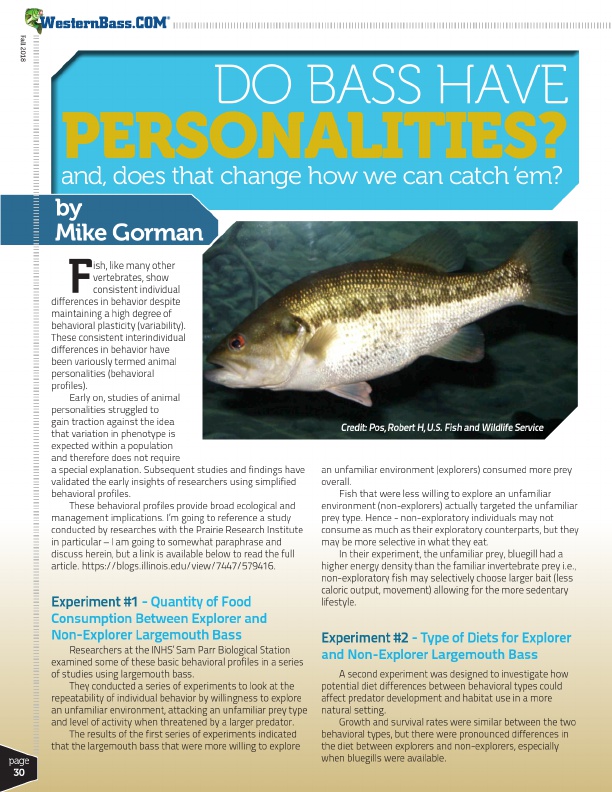
®
Fall 2018
DO BASS HAVE
PERSONALITIES?
and, does that change how we can catch ‘em?
by Mike Gorman
page 30
F
ish, like many other
vertebrates, show
consistent individual differences in behavior despite
maintaining a high degree of
behavioral plasticity (variability).
These consistent interindividual
differences in behavior have
been variously termed animal
personalities (behavioral
profiles).
Early on, studies of animal
personalities struggled to
gain traction against the idea
that variation in phenotype is
expected within a population
and therefore does not require
a special explanation. Subsequent studies and findings have
validated the early insights of researchers using simplified
behavioral profiles.
These behavioral profiles provide broad ecological and
management implications. I’m going to reference a study
conducted by researches with the Prairie Research Institute
in particular – I am going to somewhat paraphrase and
discuss herein, but a link is available below to read the full
article. https://blogs.illinois.edu/view/7447/579416.
Experiment #1 - Quantity of Food Consumption Between Explorer and Non-Explorer Largemouth Bass
Researchers at the INHS’ Sam Parr Biological Station examined some of these basic behavioral profiles in a series of studies using largemouth bass.
They conducted a series of experiments to look at the repeatability of individual behavior by willingness to explore an unfamiliar environment, attacking an unfamiliar prey type and level of activity when threatened by a larger predator.
The results of the first series of experiments indicated that the largemouth bass that were more willing to explore
Credit: Pos, Robert H, U.S. Fish and Wildlife Service
an unfamiliar environment (explorers) consumed more prey overall.
Fish that were less willing to explore an unfamiliar environment (non-explorers) actually targeted the unfamiliar prey type. Hence - non-exploratory individuals may not consume as much as their exploratory counterparts, but they may be more selective in what they eat.
In their experiment, the unfamiliar prey, bluegill had a higher energy density than the familiar invertebrate prey i.e., non-exploratory fish may selectively choose larger bait (less caloric output, movement) allowing for the more sedentary lifestyle.
Experiment #2 - Type of Diets for Explorer and Non-Explorer Largemouth Bass
A second experiment was designed to investigate how potential diet differences between behavioral types could affect predator development and habitat use in a more natural setting.
Growth and survival rates were similar between the two behavioral types, but there were pronounced differences in the diet between explorers and non-explorers, especially when bluegills were available.
https://blogs.illinois.edu/view/7447/579416